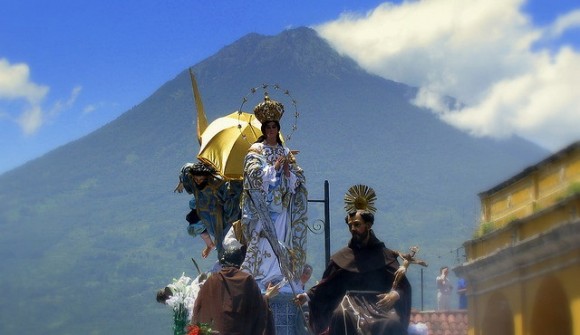 Antigua, Guatemala. The country has seen an increasing number of vigilante killings, partly the result of inequality and frustrated ambitions. Image credit: Roberto Urrea
Antigua, Guatemala. The country has seen an increasing number of vigilante killings, partly the result of inequality and frustrated ambitions. Image credit: Roberto UrreaFrom the Peruvian Highlands to rural Mexico, citizens have been especially capable in carving out an independent, less violent reality, even under conditions of protracted violence and weak states. But in Guatemala, so-called “lynchings” (linchamientos) – or spontaneous and violent vigilante justice – has quietly persisted amid the protests and more internationally-contentious drug crime. The creeping geographical spread and now increase in lynching in recent years has caused alarm among human rights organisations. It requires soul searching by citizens themselves going forward.
Lynching in local communities: a puzzling phenomenon
As I have noted elsewhere, the drivers underlying lynchings in Guatemala are poorly understood, and conflicting information persists. It was assumed that war-torn indigenous communities were most susceptible; lynchings being borne out of frustration with state authorities, or an effort to assert greater cultural autonomy. Warranted frustration does persist, but indigenous-dominated municipalities in Guatemala are among the least violent in Central America by homicide rates.
Instead, I argue, lynchings are in some part a function of seemingly immovable rates of inequality, and the bitterness of rural poverty and frustrated ambitions. Despite recent gains against corruption, the Guatemalan state has been remarkably unwilling, criminally so, to invest in basic social services and essential human development programs. But lynchings create new problems: they deepen insecurity, sow new social cleavages where none should exist, and make community action over other challenges – from education to climate change adaptation – more difficult to accomplish.
What citizens can – and must – do
- Guatemalan civil society is rich and diverse, and citizens have organised themselves around myriad themes – whether around women’s, indigenous or labour rights, for example – to lobby for systemic change. The impact of such organisations can be hamstrung by limited funds or local politics. But they can nevertheless be powerful focal points around which to assemble, peacefully argue, or grieve.
- Throughout rural Guatemala, what should be cohesive communities have been divided along new, communal lines – specifically between emerging Evangelical sects and the traditional Catholic Church. This has impacted local governance, and cooperation over development and other projects. But these divisions are not irreconcilable. Like local NGOs, local churches and their followers are fundamental nodes of community engagement and participation. Local leaders, activist citizens and courageous NGOs can exercise diplomacy to bridge these divides, while in the process building social cohesion and providing an outlet to cooperate over crime and justice.
- In other regions, indigenous organisations have significant influence over daily practices, norms and governance. The 48 Cantons of Totonicapán, for example, first rose to local prominence because of their insistence on the protection and sustainable management of sacred, local forests. Their influence has wide scope and might mitigate the worst of current lynchings.
While the state must reform and progress, it will be slow at best. Communities, meanwhile, have within them the tools to confront the challenge. Outside assistance could be valuable, but should first honour and coordinate with local nodes of power and agency, working within these parameters to end lynchings, so communities can unite against their shared challenges.







